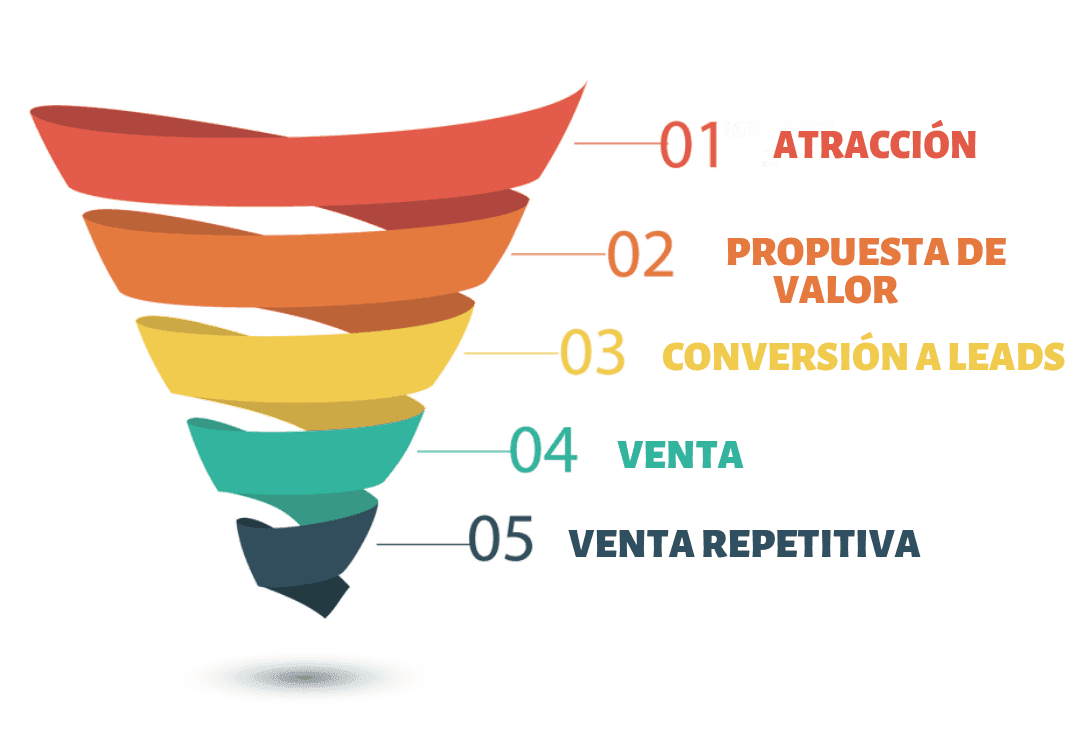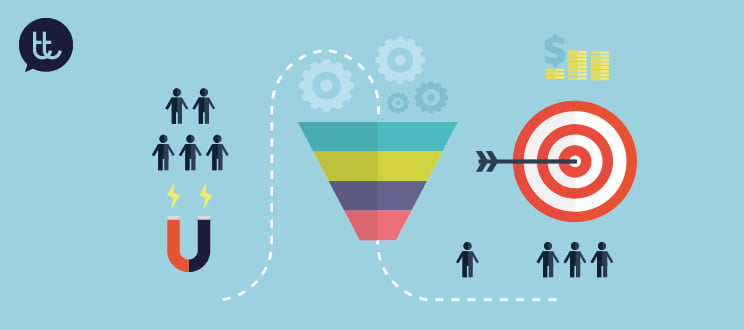Sales funnel strategies for each stage of the process(sin importar)
Sales funnel strategies are used by marketing specialists and entrepreneurs to boost sales. Sales funnels allow to know the path that a potential customer takes from their initial search for a product or service they require, to the successful conversion of their purchase. They also provide insight into the reason why some prospects withdraw before making a purchase.
Do you want to convert people who visit your physical store or website into repeat customers? In this article, I will tell you what a sales funnel is, its benefits, its stages, how to create them and I will reveal valuable sales funnel strategies you can implement to increase conversions in your business.
What is a sales funnel?
A sales funnel, or conversion funnel, is a tool used to describe the ideal steps or the ideal journey a person takes from before they know your brand to becoming your customer. It is a tool that has become an indispensable concept in business growth.
The main function of the sales funnel is to track prospects as they move through each stage of the process. In this way, strategies specific to the characteristics of each stage of the funnel can be developed.
Benefits of a sales funnel
The benefits of integrating sales funnels into your business, regardless of its size, are:
- It allows you to visualize the decision-making patterns of your leads so you can predict and direct their buyer’s journey to the sale.
- It also helps you identify the causes of abandonment, the reason why your prospects say goodbye at some stage before moving on.
- It is excellent for defining marketing strategies.
- The whole team understands how to engage with customers, thanks to their participation in the development of sales funnel strategies.
- It definitely helps to increase your sales as you will generate more leads.
- You gain important competitive advantages over other companies in the same niche.
What are the stages of the sales funnel?
A sales funnel has 6 stages:

1. Awareness
This is the awareness stage, when the prospect realizes that they need to buy something or that they have a problem that requires a solution. Prospects can develop this awareness by encountering your advertising, seeing your brand on social media, searching Google, hearing comments from friends, or reading an article of interest to them on a blog.
2. Discovery
At this stage of the funnel, your potential customers want the services or products you offer and want more information. This is the time to show the benefits of your brand and how you can help them meet their need.
3. Evaluation
In the evaluation stage, your potential customer compares and evaluates in more detail the benefits offered by different brands. Consider several options, i.e., analyze your proposals but also those of your competitors.
4. Intent
During the intent stage, the prospect is interested in buying your product or service but is still undecided and analyzes if the product really meets all his needs. Maybe he asked a question through social media or added an item to the shopping cart. Although he is close to buying, he might abandon the process when, for example, at the time of purchase, he doesn’t like the shipping methods.
5. Buy
At this stage, the prospect is ready to buy and officially becomes a real customer.
If you have a traditional sales system, the customer must interact with a salesperson (by phone, in person, by email or contact form). If your system is digitized, the customer will probably never interact with your customer service team.
6. Loyalty and Retention
Congratulations, you made the sale but the process never ends. Now, your sales funnel strategies must be aimed at retaining and keeping your customers, because even if they are happy and satisfied with the product and service, you must convert them into regular customers.
How to create a sales funnel?
Here’s how to create a sales funnel in 9 simple steps.
- Make sure you have a budget for the development of your sales funnel.
- You must have an offer that is attractive, competitive and solves a problem for your customers.
- Clearly define your business model, what is the real value of your brand, the business objectives and the sales funnel objectives.
- Develop the characteristics of your Buyer Persona, that is, the real characteristics of the fictitious character of your customers.
- Design a Landing Page as that first place where your potential customers will first learn about your brand. If they click on an ad, they could download a free guide and start interacting with your brand and its benefits. In addition, you will begin to capture information from prospects.
- Develop marketing materials for each stage of the sales funnel (infographics, downloadable guides for educational purposes, case studies, etc.).
- Designs advertising campaigns for prospects located at each stage of the sales funnel (social media ads, offers, promotions).
- Develops strategies to retain and build loyalty of prospects that became actual customers.
- Schedule periodic reviews and updates to the sales funnel. Continually analyze results and look for new ways of doing things and optimize sales funnel strategies.
Sales funnel strategies
Depending on the stage the potential customer is in, different sales funnel strategies should be applied.

Strategies for sales funnels at the awareness stage.
- Facebook has more than 2 billion monthly active users so it’s perfect for running ads to create awareness around your brand. With Facebook, you can get them to recognize your brand and attract visitors interested in what you offer.
- Develop content to get relevant traffic for free, in this step if you know about SEO it will help you. For example, infographics, blog posts, a video or a guide with solutions or suggestions on how to solve problems or situations related to the product or service you offer.
Strategies for the discovery stage
- Promote your products subtly, communicating their features and benefits without pressuring the prospect to buy. You can create ads on Facebook or instagram, and even on youtube.
- Include educational information, technical documents, guides and infographics among others.
- You can start using email marketing techniques.
Strategies in the evaluation stage
- Analyze your competition and offer what they don’t do. Optimize the content and information you deliver to customers. Offer more complete and detailed content, tips, guides, free mailings, case studies, etc.
- Use social proof techniques, i.e., the technique of assuming other people’s thoughts and actions. You can use social proof in all channels: on the website, in email marketing and in paid ads on social networks.
Sales funnel strategies at the purchase intent stage.
- Keep your product or service pages updated, with complete descriptions, relevant content for the customer and compelling calls to action. There should be no doubt about the product or the purchase process, shipping, warranties and returns.
- Develop content with clear messages tailored to your customer’s unique problem (trial offers, discounts, demos, Q&A section).
Strategies at the purchase stage
- Develop messages that subtly prompt the customer to buy in case they decide to abandon the purchase process.
- Payment gateways should be well developed, with several options and calls to action. They should also inspire trust.
- Use the incentive of free shipping.
- You can also offer free gifts to the customer who completes a purchase or a discount code for a future purchase.
- Another technique is to encourage them to read reviews from satisfied customers to convince them of the good quality and service you offer.
Sales funnel strategies at the loyalty and retention stage.
- Develop a thank you message to customers who complete a purchase. You can send it via email or use a web page that displays the message.
- Develop a brand loyalty program highlighting how important and exclusive your customers are.
- Use referral marketing techniques, offering an appropriate incentive to those who refer your brand and some incentive to the new customer.
- Send the referral plan to customers who have already purchased to attract and retain them.
- Develop email campaigns to tell your customers how important they are and how grateful you are. Take advantage of this to motivate them to buy again. You can send them the new tips guides you develop or an invitation to participate in free webinars among others.
Conclusion
Developing sales funnel strategies allows you to convert prospects into real customers, helps you to build customer loyalty and also provides you with a better understanding of your business.
The sales funnel is an effective method to track your customers’ journey through the different stages of the sales process. However, to achieve success, you must have a good online strategy and relevance as well as know how to manage digital communication tools and marketing automation.